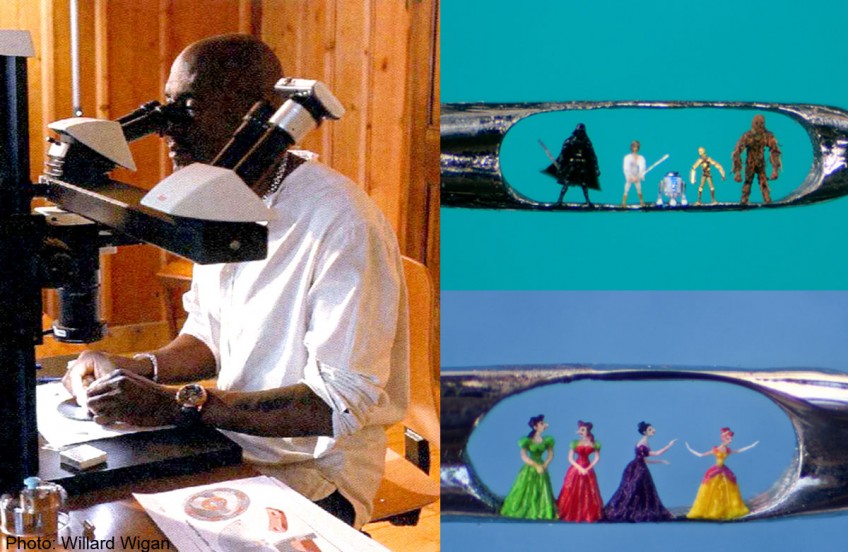Art in the eye of a needle

Most sculptors use clay, wood and marble.
Micro-sculptor Willard Wigan, on the other hand, chooses materials that are far stranger than those used by his peers.
Mr Wigan, 56, uses grains of sand, dust fibres, facial stubble and spider's cobwebs to create his unique sculptures, which are so tiny they fit onto a pinhead and inside the eye of a sewing needle.
They are so tiny that the only way to appreciate them is through a microscope.
"Sometimes, the smallest things can make the biggest impact," he told The New Paper.
"My teachers and friends told me I was nothing. 'Nothing' doesn't exist. I want to experiment with the world we can't see."
Mr Wigan, who is British, said that his path to becoming a micro-sculptor started when he was five.
He suffered from dyslexia and was humiliated and ridiculed by his teacher.
He often found solace in his fantasy world of the minute where he began experimenting with building houses, merry-go-rounds and shoes for ants he thought were homeless. He sliced splinters of wood with shards of glass and attracted the creatures to his creations with sprinkles of sugar.
"As I grew older, I impressed my mother and she kept encouraging me to go even smaller with the things I made," said Mr Wigan, who was in Singapore last week as part of a private event and exhibition for the clients of the Australia and New Zealand Banking Group (ANZ).
His works continued to decrease in size till they were no longer visible to the naked eye. Some are smaller than a human blood cell.
"What inspired me was a Bible verse about how it is easier for a camel to go through the eye of a needle than for someone who is rich to enter the kingdom of God. That's how I started going smaller, trying to fit things into needles," he said.
BEE STING
He said his work is like a bee sting - minute but lethal. He hopes to impress people who used to look down on him into believing in what he can do.
He added that his work is a constant test of perserverance.
Armed with tools like the hairs of flies to paint his sculptures, eyelashes to sculpt and a tiny scalpel with a diamond shard tip for cutting, he has to sit almost motionless at his microscope to sculpt.
Because the tiniest vibrations can cause errors, Mr Wigan said he enters a meditative state before he begins work to slow his heart, then sculpts "in between heartbeats" so that the his pulse doesn't cause his fingers to tremor.
As the vibrations made by passing traffic can easily affect Wigan's work, he often toils through the night when the city is quiet.
He is so still when he works that he describes himself as a dead man working.
Although Mr Wigan hates the excruciating process of creating his work, which can take up to four months to complete, he derives satisfaction from the results.
He said: "I have never enjoyed doing my work, what spurs me on is finishing it."
And finishing it is probably the most frustrating part of the process.
Mr Wigan said that after he is done with the sculpting and is about to fit the finished microsculpture in the eye of a needle with an eyelash, he sometimes drops his work and loses it or accidentally inhales it.
"My work is very intense. I punish my body to make the best for my collectors. It forces me to this point of concentration that sometimes drives me crazy," he said.
Collectors, who include Prince Charles and Sir Elton John, pay upwards of £50,000 (S$105,500) for his tiny art pieces.
Mr Wigan said that he will continue to push boundaries by making his sculptures not only smaller but also more intricate.
"Sculpting is getting harder because my work is getting more detailed," he said.

Get The New Paper for more stories.